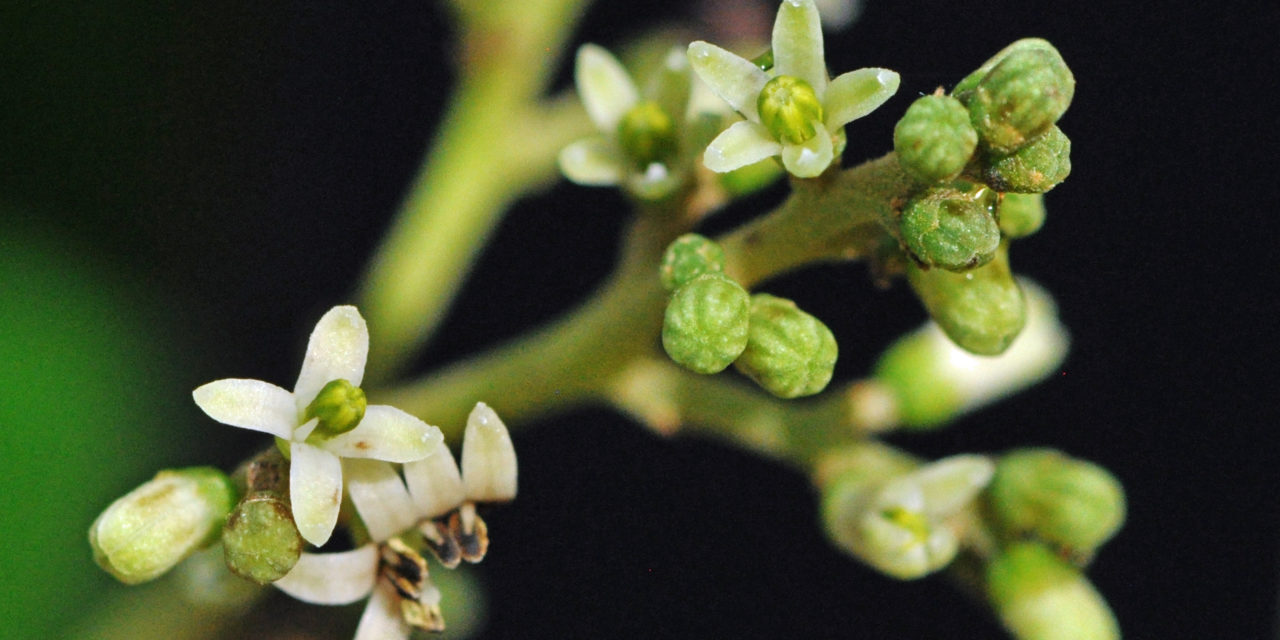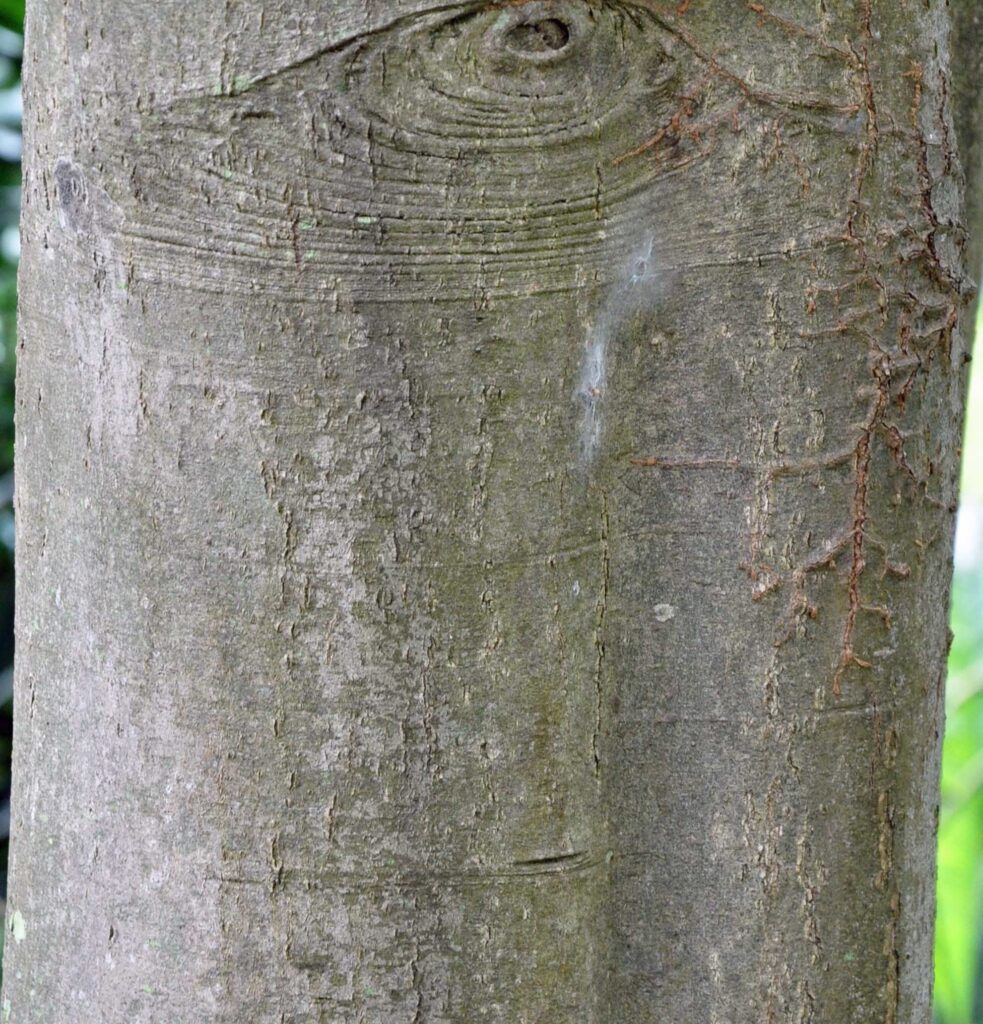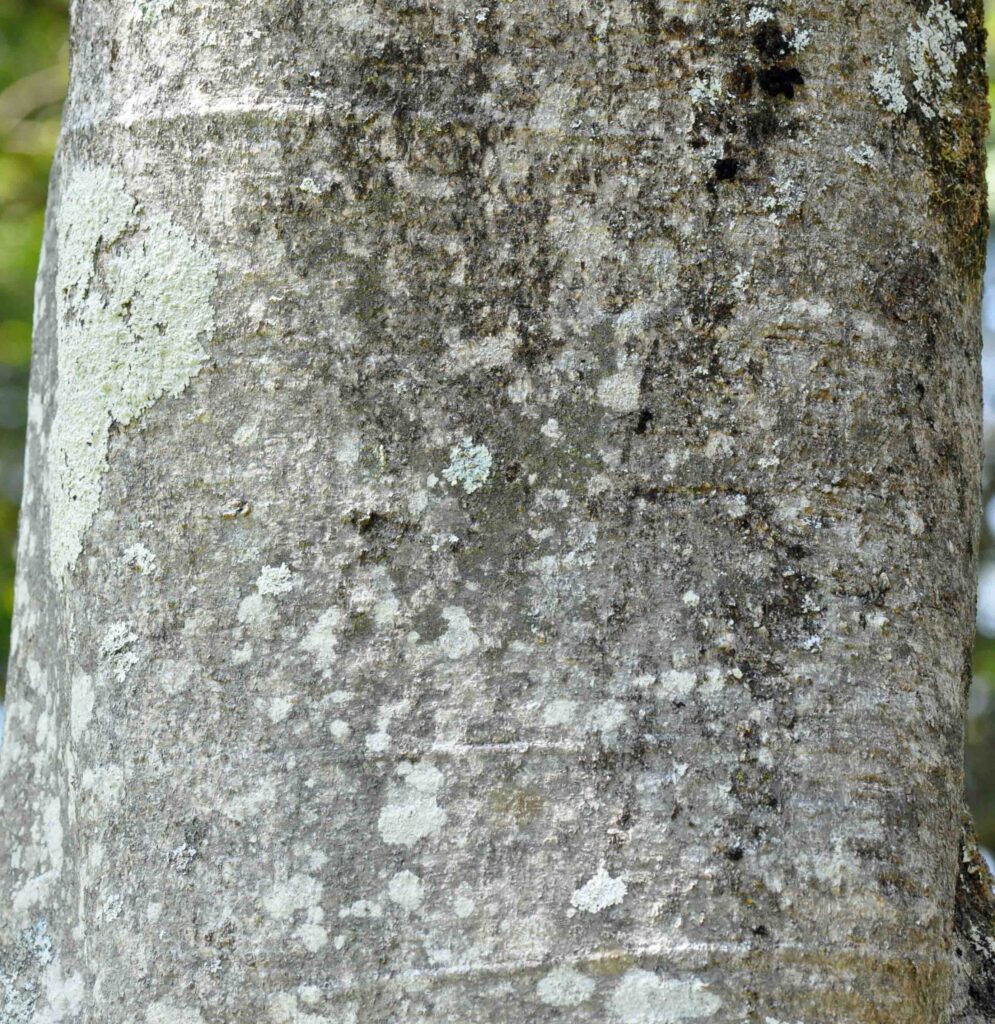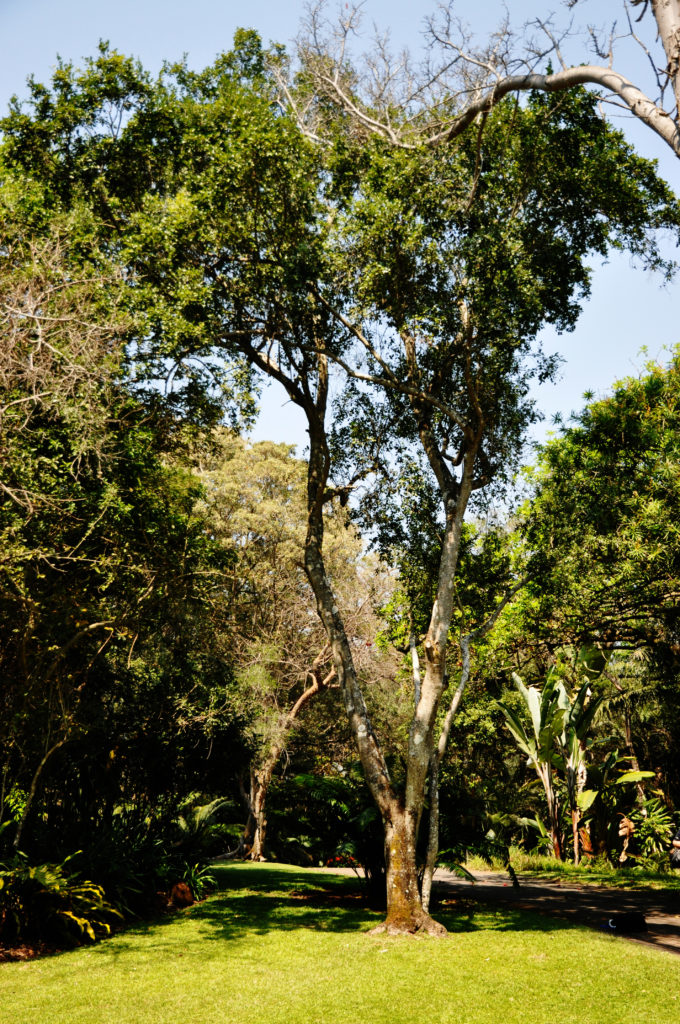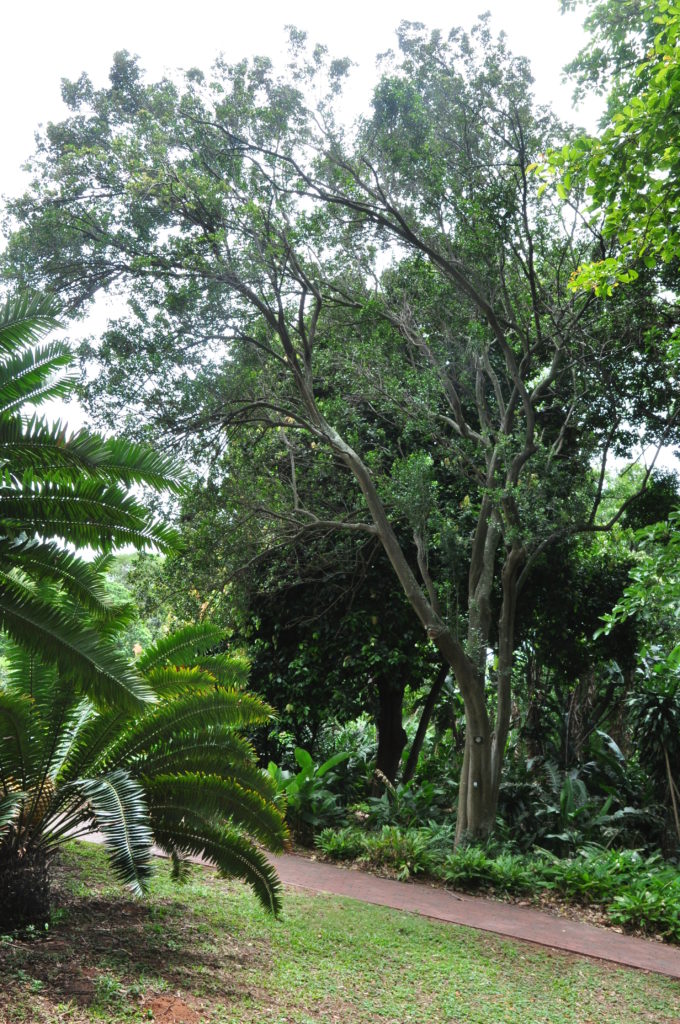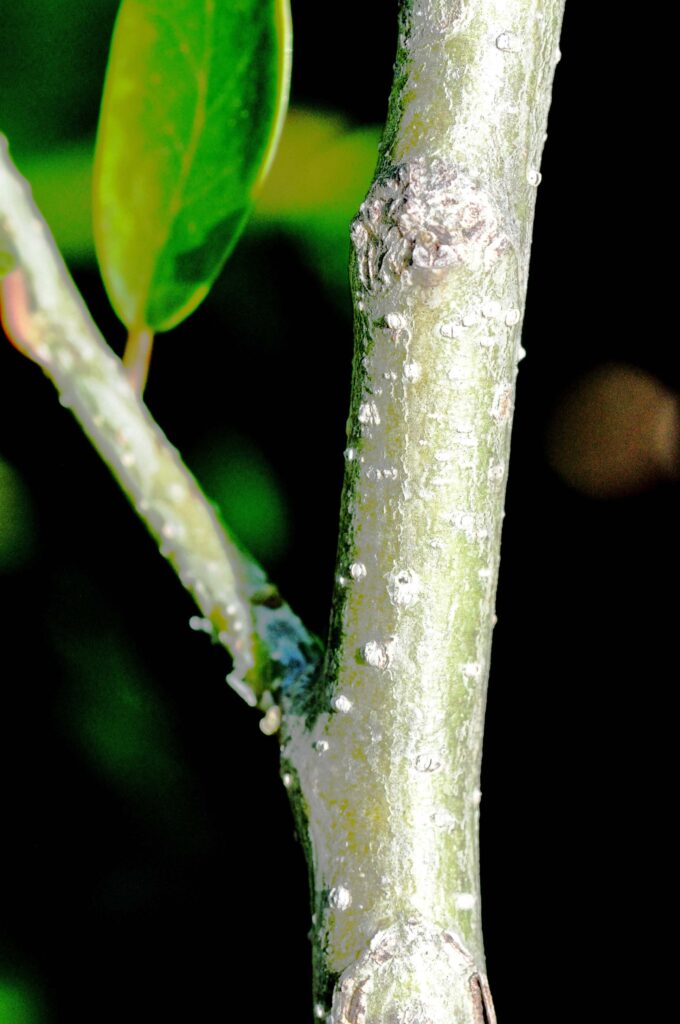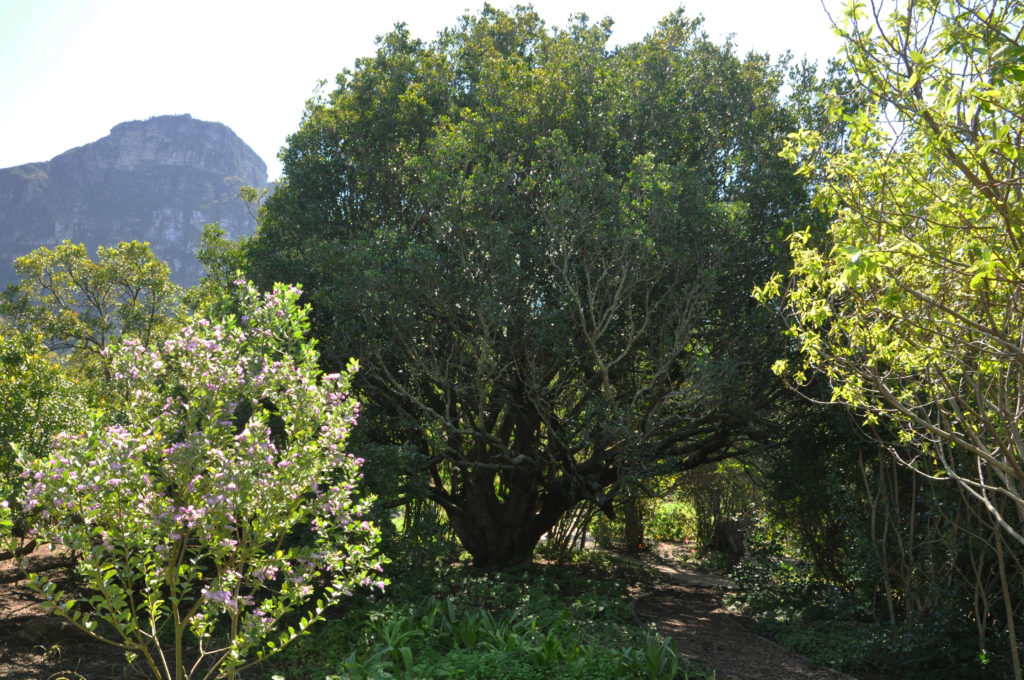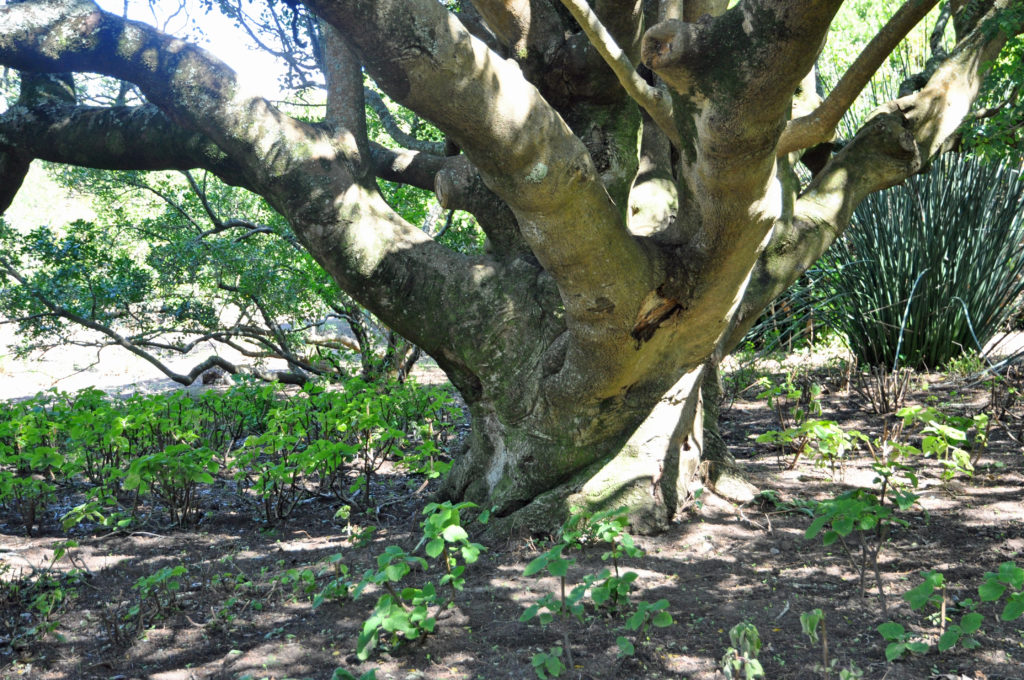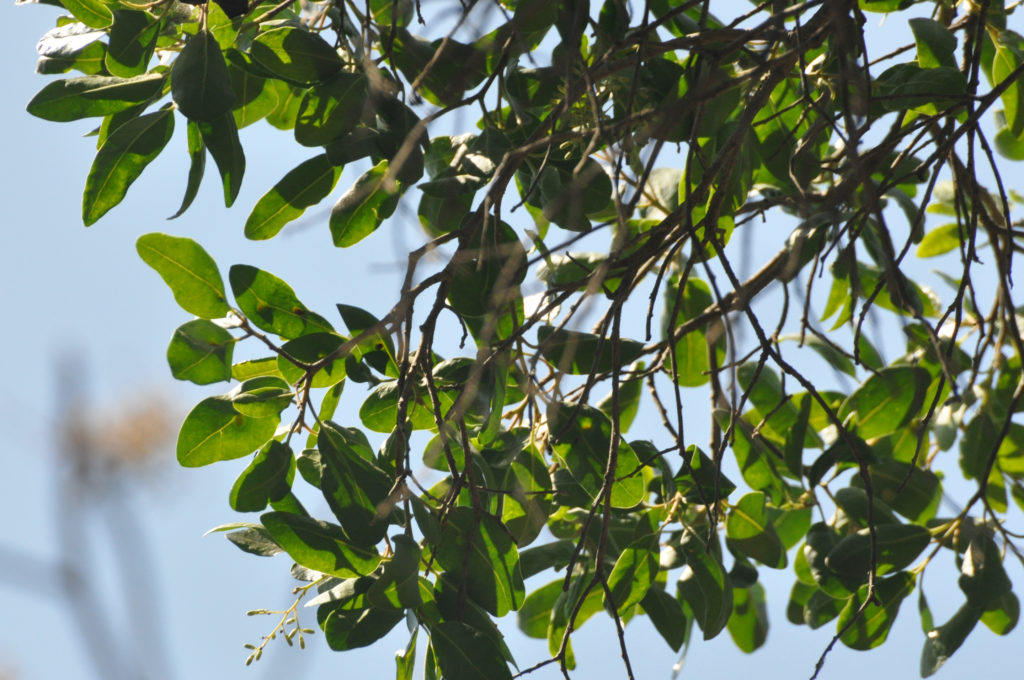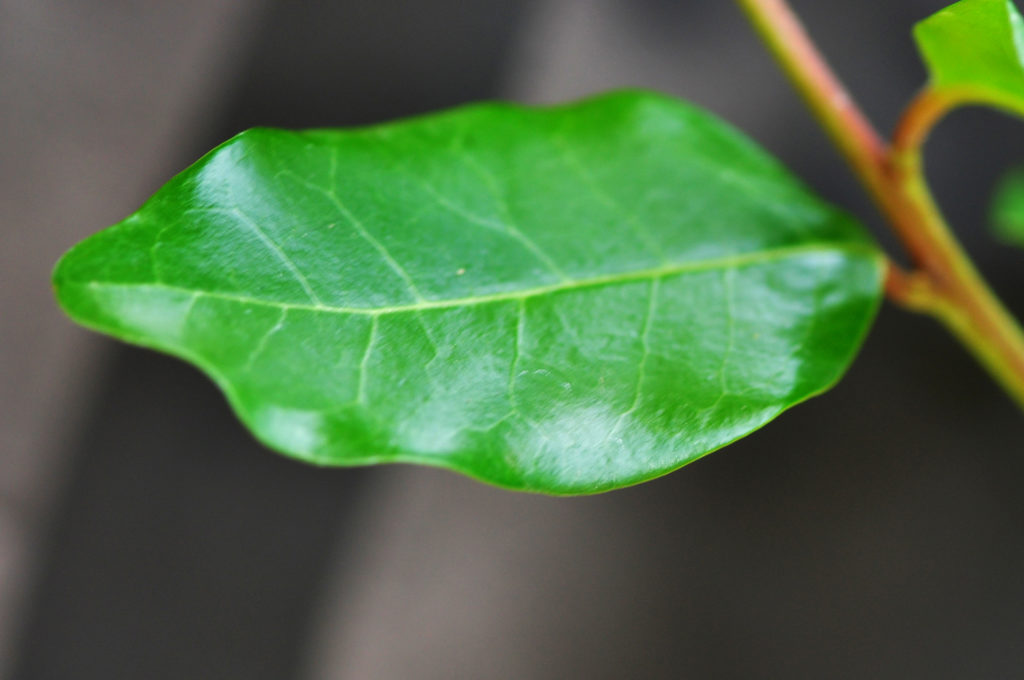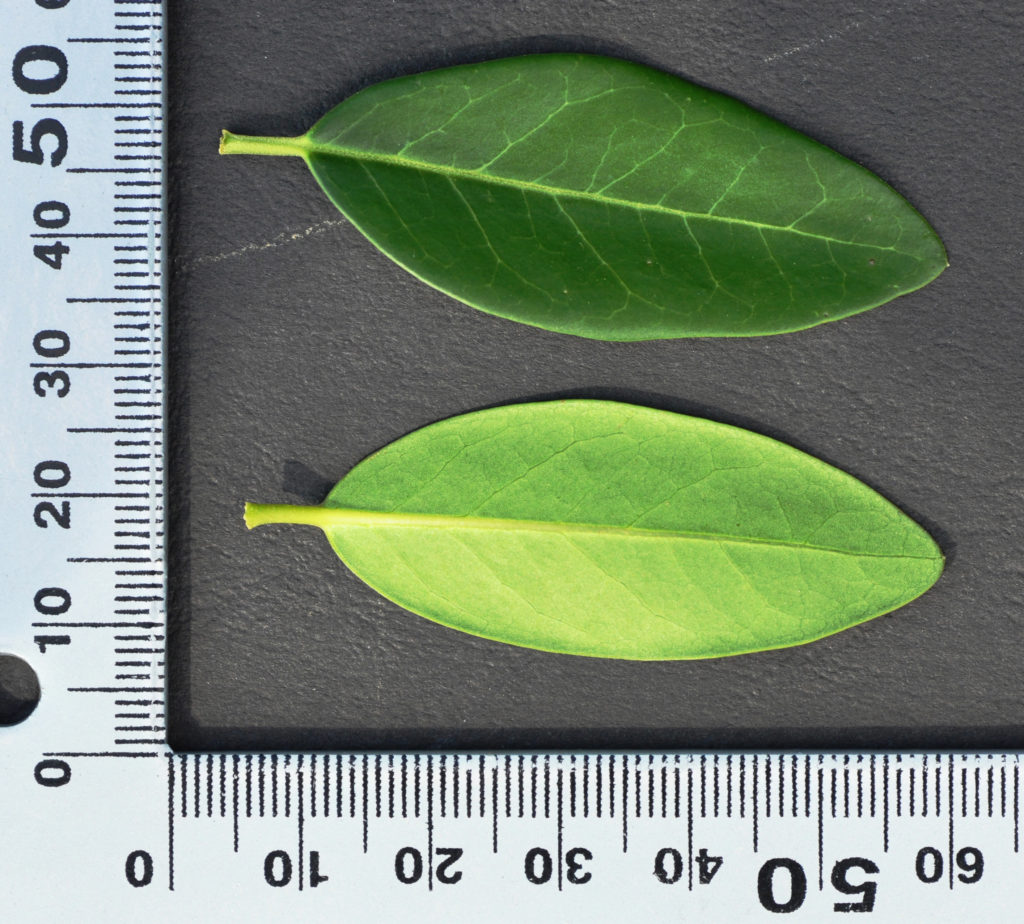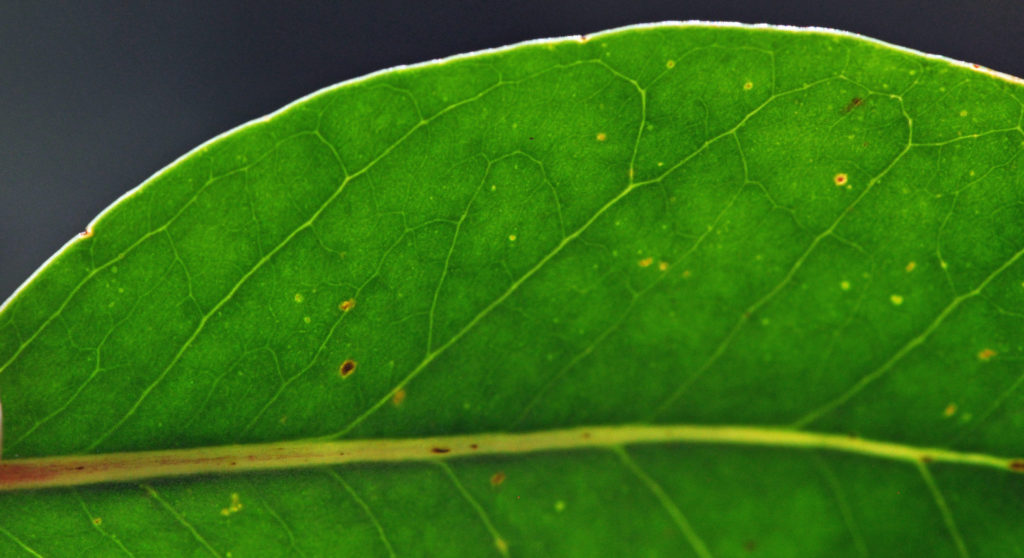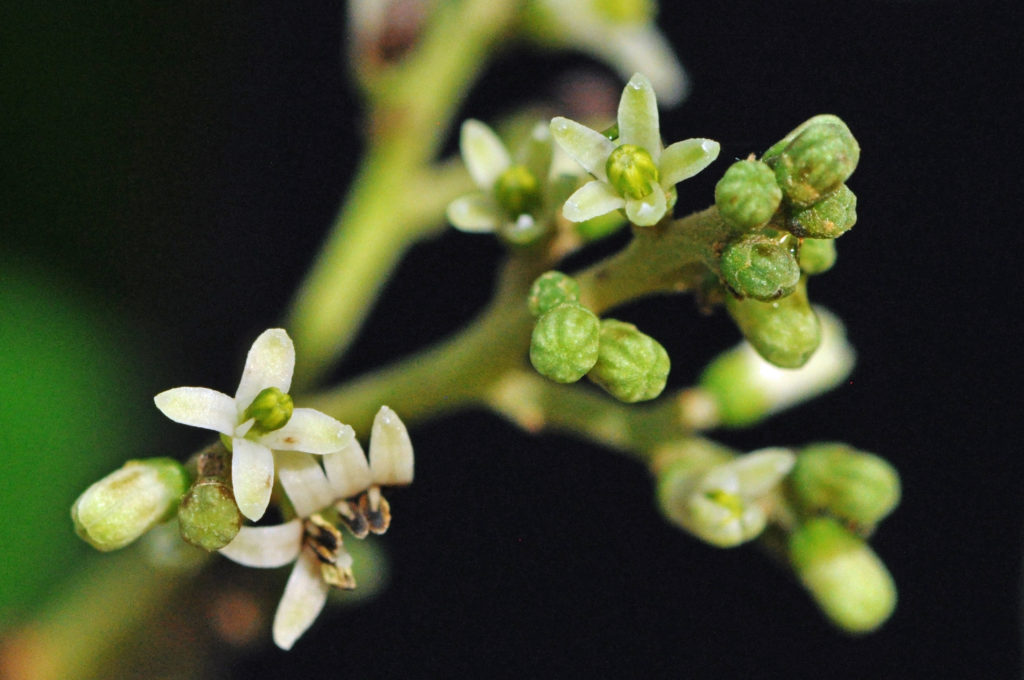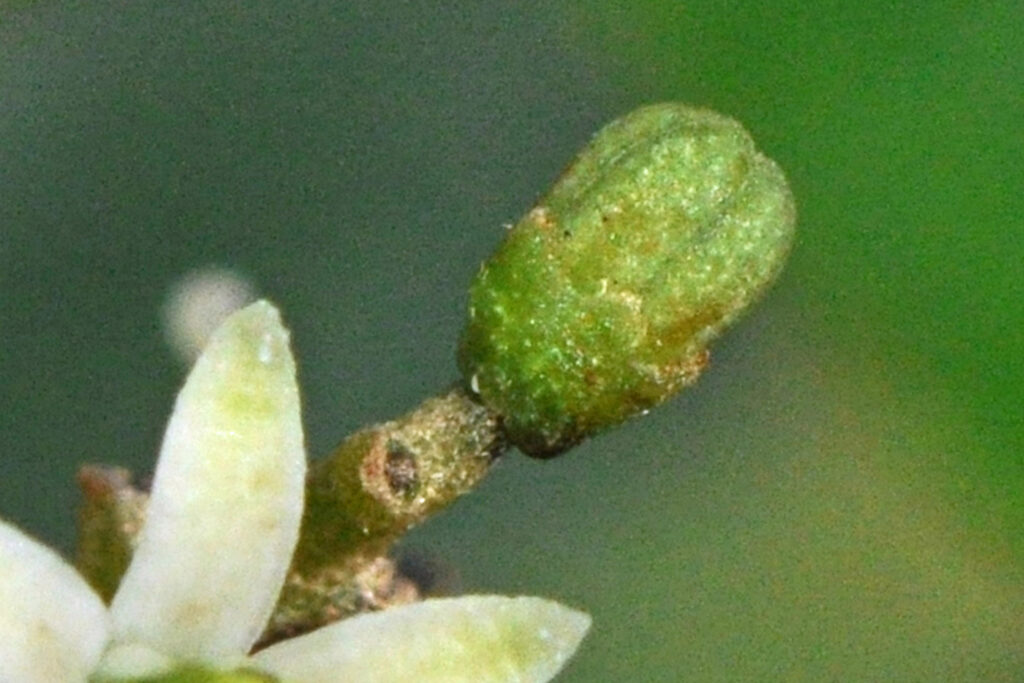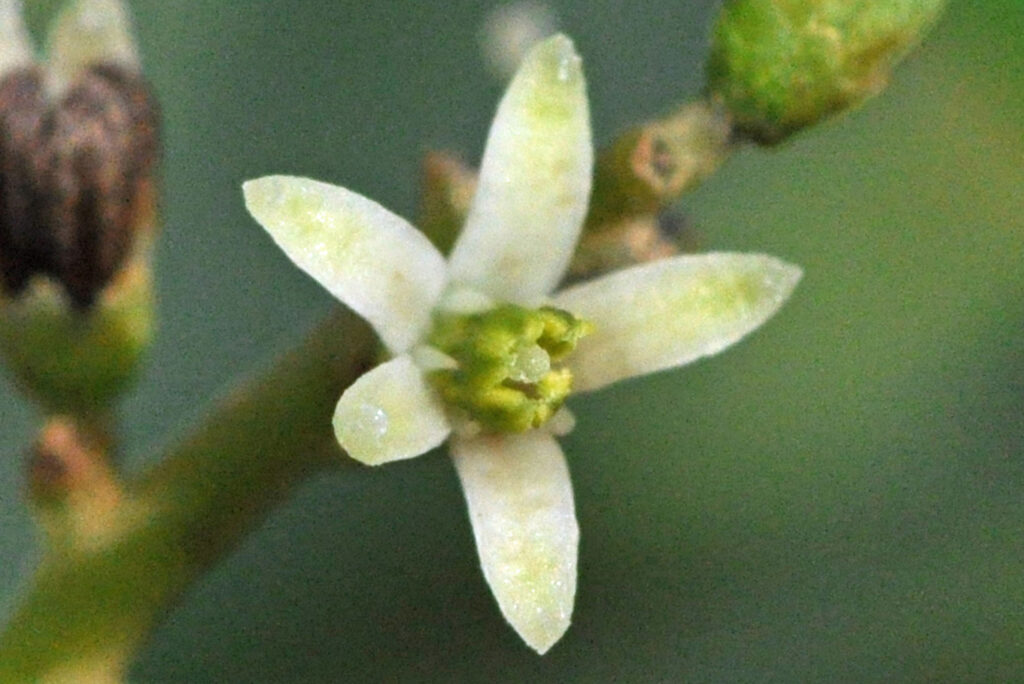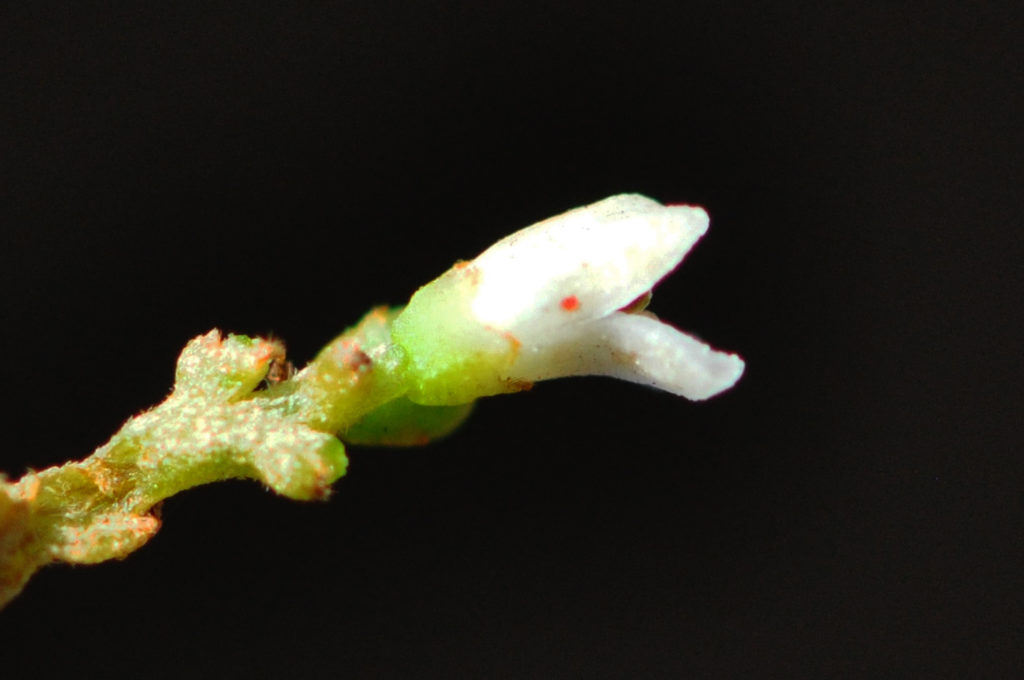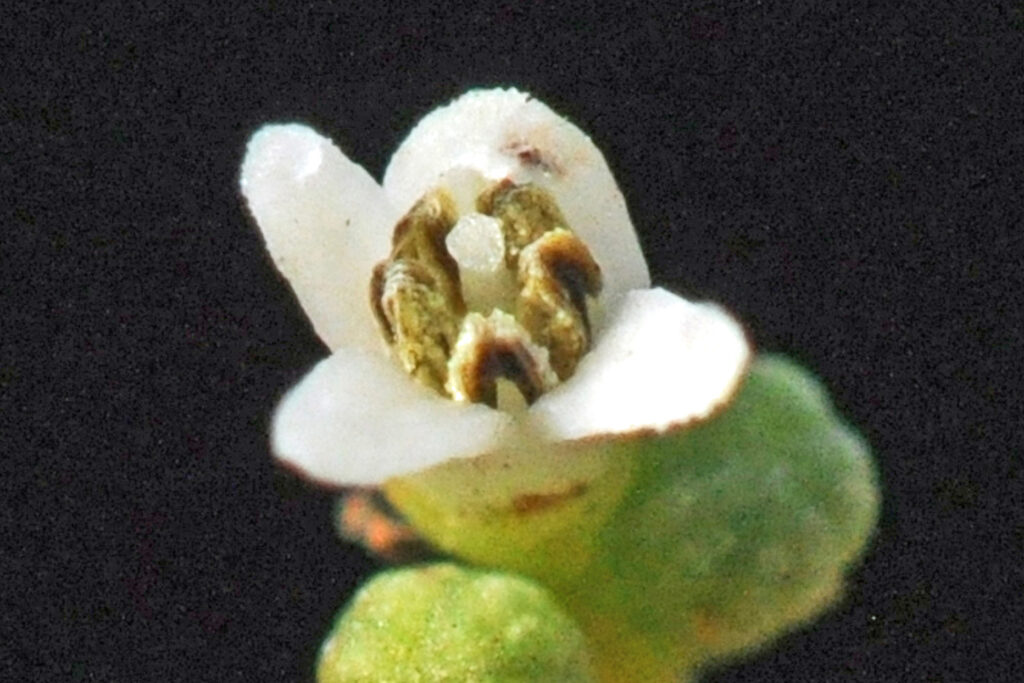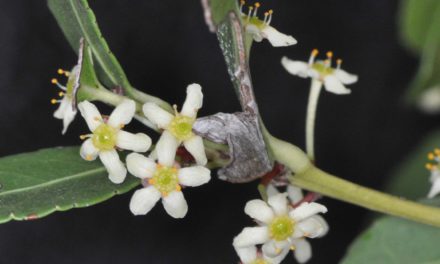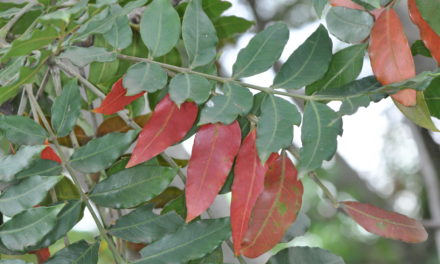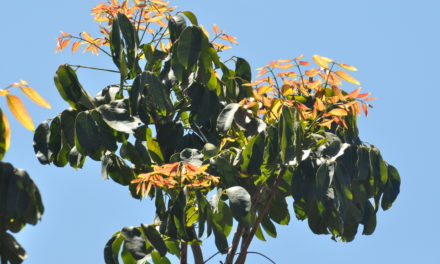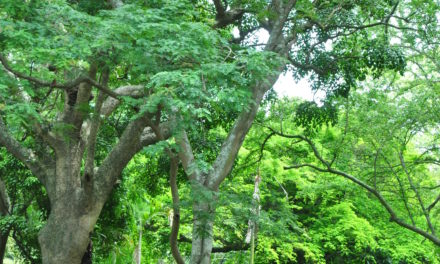Apodytes dimidiate subsp. dimidiate
General Info – summary
This variable evergreen Tree with smoothish bark may reach 20m high. Alternate spirally arranged simple Leaves with entire margins. Small, cream or white, regular, scented and 5-merous Flowers develop in cymose panicles. Free petals with attached stamens. Stamens 5. 1-locular pistil & a superior ovary. Small kidney-shaped Fruit is a drupe with a small persistent style on one side. Seeds may have a coloured aril.
Description
Previous Names: Apodytes acutifolia, Apodytes emirnensis, Apodytes inversa.
SA Tree No. 422.
Common Names: (Afr) Witpeer. (Eng) Bird’s eye, White Pear. (isiXhosa) Umdakane. (isiZulu) Umdakane, Umdzagame. (Northern Sotho) Kgalagangwe, Mmetla-kgamelo, Sephopha-madi. (siSwati) umDzakane. (Tshivenda) Tshiphopha-madi.i.
Family: Metteniusaceae. (Previous family Icacinaceae). This family of flowering plants exists mainly in the tropics. These plants may be lianas, shrubs or trees. This family has recently increased the numbers from 1 to about 10 genera and about 50 species. Flowers are fragrant. Exserted Stamens are connected to the petals. The free 1,5cm long Filaments are curled backwards. Anthers are moniliform (resembling a string of beads). Ovaries contain 1 ovule, and the Style is up to 2cm long.
Name derivation: Apodytes – Greek: to strip: the calyx is too small to cover the corolla petals. dimidiate – divided into 2 equal parts: referring to the half-covered fruit. The 8 species of evergreen trees in the genus Apodytes are found in NE Australia, Asia, New Caledonia (in the SW Pacific Ocean) and Africa. Subsp. dimidiate is only found in southern Africa.
Conservation: National Status: L C. (Least Concern). Assessed: Raimondo et al. (2009).
Tree
This medium sized bushy Tree is usually 4-5m high but in deep forests it may reach 20m. The initially smoothish Bark (photos 229 & 757) is white, pale grey or pale green, and may become roughish and darker with age. The trunk (photo 427) may peel off in patches becoming irregularly fluted (funnelled, channelled: having or marked by grooves) and is seldom round (photos 760 & 230). Here the girth (the measurement around the trunk) is up to 2,5m. This plant may also be a twisted shrub no more than 1m high. Smaller isolated trees are graceful and have a compact crown (photo 426). Different coloured Lichen (composite organism arising from a mutualistic relationship between fungi or cyanobacteria and algae species) are often present and effect the trunk colour (greenish in photo 757). Young stems may be purplish red with short brown hairs. Here protruding Lenticels (usually raised corky oval or elongated areas on the plant that allows the uncontrolled interchange of gases with the environment may be visible – photo 783).
- 229. 2015/02/09. Durban BG. Photo: David Becking.
- 757. 2014/09/16. Lowveld NBG. Photo: David Becking.
- 760. 2014/09/16. Lowveld NBG. Photo: David Becking.
- 230. 2015/02/09. Durban BG. Photo: David Becking.
- 783. 2014/11/18. Walter Sisulu NBG. Photo: David Becking.
- 426. 2018/09/16. Kirstenbosch NBG. Photo: David Becking.
- 427. 2018/09/16. Kirstenbosch NBG. Photo: David Becking.
Leaves
On this evergreen tree, the often shiny, alternate and slightly leathery Leaves are simple (have a single blade which may have incisions that are not deep enough to divide the blade into leaflets – photo 694). The spirally arranged, soft leaves are glossy, dark green above, lighter and duller below (photo 780). They are occasionally hairy among the basal portion of the lower side midrib. Leaves are ovate to obovate to elliptic and up to 15 x 8cm (usually 5-7cm long – photo 780). They are often larger near the coast. The Apex is narrow to broadly tapering and possibly notched. The Base is broadly tapering to rounded and may be pink. The Midrib is usually yellowish, visible on both sides, sunken above and protrudes below. It may be flushed with pink (photo 424). The rolled under Margin is entire (with a continuous margin, not in any way indented) and may be wavy (photo 694). Observing the leaves against a strong light is the best way to study the veins (photo 424). Here the lateral veins arch and join other lateral veins before reaching the margin. The Petiole (leaf stalk) is up to 2cm long, grooved above (photo 780) and may be pinkish red (photo 694). If the leaves are bent and slowly twisted apart the fine thread connecting to the midrib will become visible. This helps to confirm ID. Pressed leaves tend to dry black.
- 671. 2014/09/14. Lowveld NBG. Photo: David Becking.
- 694. 2014/09/13. Lowveld NBG. Photo: David Becking.
- 780. 2014/11/18. Walter Sisulu NBG. Photo: David Becking.
- 424. 2018/09/16. Kirstenbosch NBG. Photo: David Becking. Leaf against the sun.
Flowers
The small, cream or white Flowers develop in profusion and are individually about 5mm in diameter. They develop in leaf axils (the upper angle between a lateral organ, such as a leaf, and the stem that bears it) and stand out beyond the leaves. Flowers are heavily scented especially in the early morning. They are located in terminal clusters and are cymose (a broad, more or less flat-topped, determinate flower cluster, with central flowers opening first) panicles (indeterminate, branched inflorescence with stalked flowers – photo 348). Young terminal branches and leaf petioles are a distinctive red. They are bisexual and actinomorphic (Regular, symmetrical. Flowers are vertically divisible into similar halves by more than 1 plane passing through the axis). The small saucer-shaped Calyx is slightly 5-toothed (photo 350). The Corolla has 5 Petals that are free and valvate (meeting at the edge without overlapping – photo 349). The 5 Stamens alternate with petals (photo 125) and are joined to them. Each Anther is 2-thecous (has 2 pollen sacs). These open and dehisce through longitudinal slits. There is a single Pistil (a unit of the Gynoecium, the female element of the flower, composed of the Ovary, Style and Stigma) and the superior Ovary has 1 locule with 2 pendulous ovules. Then Style is terete (circular in cross-section) ending in a small Stigma (photo 125). Pollinators include bees. (Sep-Apr).
- 348. 2018/01/16. Pretoria NBG. Photo: David Becking.
- 350. 2018/01/16. Pretoria NBG. Photo: David Becking.
- 349. 2018/01/16. Pretoria NBG. Photo: David Becking.
- 127. 2018/03/14. Pretoria NBG. Photo: David Becking.
- 125. 2018/03/14. Pretoria NBG. Photo: David Becking.
Fruit
The many, initially green, almost hairless young Fruit turns a distinctive grey or red when mature. It is a berry-like compressed drupe (or stone fruit – a fleshy, indehiscent fruit with the Seed enclosed in a stony endocarp – like a peach) with a large lateral, fleshy appendage. When mature, the seeds (6 x 3mm) may be partly covered by a distinctive orange to scarlet or black lateral Aril (an appendage or outer covering of a seed and may appear as a pulpy covering) giving the fruit a reniform (kidney) shape. The aril becomes grey with age. The fruit is small and round with a persistent, thin Style that remains on one side of the base. When in full fruit, the tree turns a shiny scarlet and black, and this helps with identification. Parasites may disfigure the fruit. Seeds have a fleshy endosperm (the starch and oil-containing tissue of many seeds; often referred to as the albumen). (Dec-Jul).
Distribution & Ecology
These trees are located from sea level to medium altitudes, in evergreen forests (like Knysna, George and Tsitsikamma), bushveld, rocky outcrops, mountain slopes and sloping grassland. Outside the forests, it is a graceful smallish tree with a compact crown. In less favourable conditions like sandy dunes and coastal bush, it may be a small, twisted shrub up to 1m high. Severe frost and drought may limit plant growth. Trees are located in the Western Cape – including Table Mountain, Eastern Cape, in Masikabaformation sandstone (along the south coast of KwaZulu-Natal), Mpumalanga, Gauteng, Limpopo and North West. Beyond South Africa these plants occur in Eswatini (Swaziland), Mozambique, Zimbabwe and northwards into tropical Africa – including Ethiopia, Kenya and Nigeria. Leaves are used to kill snails. Black rhinos browse the Bark and Leaves. In the early morning, when the scent is high, bees visit the Flowers and aid in pollination. Fruit is consumed by Birds such as sparrows, starlings, pigeons, bulbuls, white-eyes and Sturmus vulgaris (common starling – introduced to the cape by Cecil John Rhodes in 1897) consume the Fruit.
Ethnobotany
In the home (outside a forest) this tree can become very graceful. The strong, very hard, dense, elastic, and fine textured Wood is pale pinkish brown. It is easily worked and takes a good polish. Wood is used for building, useful furniture, fuel and for construction of fish kraals and agricultural implements. In the past, it was used for wagon construction. The tree grows from slow germinating Seeds – which should be sown in winter. These plants grow well in areas with ample water supply. In cold areas, it can be grown as an attractive hedge. Leaves may be used to kill snails. They may also be boiled and mixed with food. The Roots are not invasive. The pink young stems and petioles are distinctive. This evergreen Tree has attractive foliage and is suitable for a small garden – providing all year-round shade. The root, bark and leaves are used in local medicine. This is a protected tree in South Africa.
References
Boon, R. 2010. Pooley’s Trees of eastern South Africa. Flora and Fauna Publications Trust, Durban.
Burrows, J.E., Burrows, S.M., Lotter, M.C. & Schmidt, E. 2018. Trees and Shrubs Mozambique. Publishing Print Matters (Pty) Ltd. Noordhoek, Cape Town.
Coates Palgrave, M. 2002. Keith Coates Palgrave Trees of Southern Africa. edn 3. Struik, Cape Town.
Foden, W. & Potter, L. 2005. Apodytes dimidiata E.Mey. ex Arn. subsp. dimidiata. National Assessment: Red List of South African Plants. Accessed on 2025/02/24.
Ginn, P.J. McIlleron, W.G. Milstein, S. 1989. The Complete Book of Southern African Birds. Struik Publishers (PTY) LTD. Third impression 1991.
Lawrence, G. H. M, 1951. Taxonomy of Vascular Plants. The Macmillan Company, New York. Tenth Printing 1965.
Palmer, E. & Pitman, N. 1972. Trees of southern Africa. Balkema, Amsterdam, Cape Town.
Schmidt, S. Lotter, M. & McCleland, W. 2002. Trees and Shrubs of Mpumalanga and the Kruger National Park. Jacana, Johannesburg.
van Wyk, B. & van Wyk, P. 1997 Field guide to Trees of Southern Africa. Struik, Cape Town.
http://www.plantzafrica.com/plantab/apodytesdim.htm
https://en.wikipedia.org/wiki/Apodytes_dimidiata
http://posa.sanbi.org/flora/browse.php?src=SP
http://www.kew.org/science/tropamerica/neotropikey/families/Metteniusaceae.htm.
en.wikipedia.org/wiki/Apodytes

